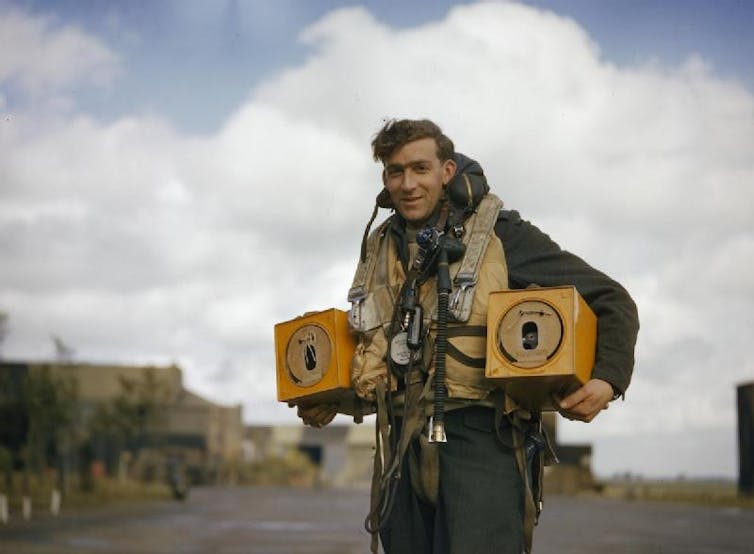
Rob, who allegedly made more than 20 parachute descents, receiving a Dickin Medal in 1945.
It’s the 74th anniversary of D-Day, and veterans and world leaders are meeting on the beaches of Normandy to commemorate the biggest seaborne invasion in military history. Memorial services are to recognise the estimated 4,500 soldiers who died that day.
There were also some lesser known troops involved in the Normandy landings: animals played a key part in the operation. The British army parachuted dogs on to French soil prior to the invasion to locate mines and booby traps during the D-day landings.
There were many different kinds of dog infantry during the war, who had different roles on land, sea and in the air. As well as deploying mine dogs, Allied and Axis forces used sled dogs, patrol dogs and messenger dogs. Some achieved celebrity status, such as Basme, a Saint Bernard who became the mascot of the Royal Norwegian Force after having cut his teeth on the mine-sweeper Thorodd. In an echo of World War II, dogs performed military tasks, whilst becoming symbols of loyalty, bravery, and national identity.
So animals were very much part of the war. The armies relied on them despite the highly mechanised character of warfare between 1939 and 1945.

Russia, 1942.
Horses had an enormous part to play in World War I, as Michael Morpurgo’s War Horse has recently brought back to the public imagination. In World War II the French had some cavalry divisions, and most of their artillery units were drawn by horsepower. And then the majority of German infantry units still relied on horses for transportation, despite the image of technologically advanced Blitzkrieg tactics.
As horses became exhausted during the rapid German advance through France, French military and civilian horses were requisitioned. Germany also mobilised hundreds of thousands of horses on the Eastern Front. In 1942 the Wehrmacht had 400,000 horses under its control for its invasion of the USSR, using them to pull artillery pieces and other material.
Pigeons were also pressed into service as “feathered messages”. The British Royal Air Force established a Pigeon Section with some RAF bomber crews carrying pigeons to fetch help in the event of an emergency. Pigeons were used to liaise with secret agents and resistance groups in France as well. And the British were not the only ones to exploit their possibilities: by the end of the war the US Army Pigeon Service reportedly boasted 55,000 birds.

Crewman with homing pigeons, 1942.
Pests
Whilst armies mobilised some animals to wage war, they also fought against others. US armed forces, for example, led a sustained campaign against malaria carrying mosquitoes in the Pacific. Initial malaria control measures were weak, and there were widespread malaria epidemics. In the early stages of the war, malaria caused eight to ten times more casualties among US forces than Japanese troops achieved in battle.
In 1943 General Douglas MacArthur took matters in hand, ordering the deployment of malaria control units, the use of prophylactic drugs, such as quinine, and better education for troops. The measures paid off and by June 1944 the malaria rate amongst troops had dropped by 95%.
The logic of totalised warfare that prevailed also led to US entomologists developing new technologies to annihilate lice and mosquitoes – the most significant of which was DDT spraying. The use of DDT is one of the war’s most profound environmental and social legacies, remaking ecosystems and causing human DNA damage.
On the home front, too, attempts to control pests were widespread. Insects and rodents threatened vital national resources, particularly food supplies. The British government attacked rabbits, rats and other rodents that threatened agricultural output. Moves against the creatures included the Rabbits Order of October 1939 (no. 1493), which empowered County War Agricultural Executive Committees to destroy rabbits deemed harmful to crops.
Scientists joined the fray. The leading light of animal ecology in Britain, C S Elton, secured funding from the Agricultural Research Council to allow his Bureau of Animal Population to develop the most effective way of killing rats, rabbits, and mice. And so the demands of total warfare led to new knowledge about Britain’s rodents, new policies against them. Having conducted surveys of mouse and rat populations, the bureau perfected its technique of delivering poisoned bait using a range of experimental methods, including infra-red photography.
Elton and others pushed for more effective and closely-managed pest control to be extended into peacetime, principally through the Prevention of Damage by Pests Act (1949). As with DDT, wartime pest control in Britain aimed to use scientific knowledge and new technologies to annihilate whole species. This had lasting legacies for the postwar period.
![]() Combatant nations treated animals as both allies and enemies. They played important roles as combat auxiliaries, and presented a formidable problem as pests and disease carriers. And so, the legacy of animals in the World War II goes far further than the grave of Brian, the paratrooper dog.
Combatant nations treated animals as both allies and enemies. They played important roles as combat auxiliaries, and presented a formidable problem as pests and disease carriers. And so, the legacy of animals in the World War II goes far further than the grave of Brian, the paratrooper dog.
Chris Pearson, Senior Lecturer in Twentieth Century History, University of Liverpool
This article was originally published on The Conversation. Read the original article.





